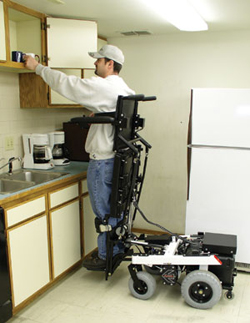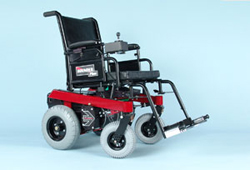Symptom Awareness: Mobility Independence and Safety, Part III
by Patricia G. Provance, PT, MSCS
Part III: Wheeled Mobility

Standing wheelchairs provide the physical and psychological benefits of being upright. Photo courtesy of 21st Century Scientific, Inc.
Part I of this series focused on ambulation issues and Part II outlined the importance of exercise. These appeared in the Fall 2008 and Winter/Spring 2009 issues of The Motivator, respectively. In this third and final segment, we will discuss the many complex considerations related to wheeled mobility.
It is not possible to include all of the options in a short article, so the emphasis here will be on outlining the many factors to be considered, the pros and cons of each type of equipment, and resources to further your education. Individuals with MS who require wheeled mobility most or all of the time should be evaluated by a seating specialist, usually a physical therapist (PT) or occupational therapist (OT) with extensive training in this area. Preferably, this should be done in a “seating clinic,” also attended by a family member and/or care partner, along with a rehabilitation technology supplier (RTS) representing a durable medical equipment company. This will help ensure that the most appropriate device is prescribed for each individual situation. It is also important to keep in mind the often progressive nature of MS, and the fact that funding sources usually dictate that a chair last for five to seven years.
Factors that need to be considered are:
- The person with MS – Individual factors and symptoms include balance, spasticity, weakness, ataxia, sensory problems, pain, fatigue, poor vision, cognitive impairment, transfer independence and safety, history with previous equipment, etc.
- The device – Many diverse considerations are needed here, including manual versus power, chair base, support surface, seating, height, width, foot rests and armrests, modifiability, aesthetics, repairs, warranties, etc.
- One’s environment – Variables include home and work accessibility (indoors, entrances/exits), weight, transportability, and community access
- One’s lifestyle – Activities the person needs and wants to perform when seated in the device
Manual Wheelchairs

MANUAL WHEELCHAIRS
Advantages
– Relatively inexpensive
– Relatively light weight
– Relatively easy to transport
– Relatively easy to maintain and repair
Disadvantages
– May not provide an individual with independent mobility in all environments
– May increase fatigue
– Tilt and recline features cannot be operated independently
Standard – Lower-end, basic wheelchairs with folding frames, but limited adjustability. Not recommended for a full-time wheelchair user, but can be used as a back-up chair for easier transport in a car or van.
Performance – Lighter weight manual wheelchairs with folding or rigid frames and more adjustability. However, fatigue is still an issue with self-propulsion by MS patients and must be considered.
Positioning – For those dependent for propulsion and repositioning who cannot propel a power mobility device. The manual tilt-in-space is not portable by car and the recliner is not advised for those with “extensor spasticity,” which is an increased muscle tone that causes the legs and trunk to straighten and stiffen.
Power Mobility Devices
Folding Power Wheelchairs – Heavy models have some seating options but are difficult to transport. Lighter models give less support.
Power-Assist and Conversion Units – These are devices that can be added on to manual wheelchairs to augment a person’s ability to propel the chair. Portable by car, but expensive and do not have power seating options.
Power Scooters – Appropriate for those who do not need significant postural support and do not anticipate a significant decline in function. Range in size, cost and features from a compact “travel scooter” to a large, stable “power operated vehicle” (POV) adequate for full-time use. Four-wheeled models are more stable but have very limited leg room.
Non-folding Power Wheelchairs – Suitable for people with MS who have significant mobility impairment because they can be customized for a variety of needs. The seating clinic evaluation will include assessment and recommendation of many features, including chair seat and back (pressure relief and positioning), arm/leg/head rests, electronics and drive controls, and other power options (tilt, recline, elevating leg rests, and seat elevator). It is important that the power base chosen will accommodate modifications that may be needed over time. Due to size and weight (200-300 pounds), they require a van with ramp or lift for transport. A trial with the proposed equipment is important before a prescription is made. These chairs are classified by the position of their drive wheels:
- Rear-wheel drive – have good front stability, turn slowly, track straighter, and are intuitive to drive, but have the largest turning radius so they are less ideal for indoor use.
- Front-wheel drive – the least prescribed because maneuvering is less intuitive, and speed is limited due to fishtailing, though they handle well outdoors.
- Center-wheel drive – maneuvers well both indoors and outdoors, has a small turning radius and newer models have two smaller wheels in both front and rear for additional stability. Even for those who have used a scooter or rear-wheeled drive chair in the past, training may be needed to become accustomed to center-wheel drive.

Rear-wheel drive power wheelchair. Photo courtesy of 21st Century Scientific, Inc.
Standing Wheelchairs – Provides the psychological benefit of being upright. Allows weight bearing through the legs, pressure relief, and muscle stretch, while building endurance. Also improves circulation, digestion, elimination, and respiratory function. However, these are very expensive and funding is difficult.
Environment and Lifestyle
Although we expect that the need for wheelchairs will diminish in the coming years since the introduction of disease-modifying therapies, historically, it has been estimated that 25 percent of people with MS will eventually need to use a wheelchair (usually power) full time for mobility, while 60 percent will be part-time users of wheelchairs (usually manual) or scooters for travel, shopping, and outdoor activities.
Proper planning is essential to avoid a poor match, so it’s important to resist the temptation of easy access via television and internet offers – some sounding “too good to be true!”

SCOOTERS
Advantages
– Generally less expensive than a power chair
– Most users feel they do not look as “disabled”
– Many models are lighter than power wheelchairs
– Some can be disassembled for transport in a vehicle (check weight of heaviest component)
– Swivel seats allow easier transfers
Disadvantages
– Requires greater strength and dexterity to operate
– No options for alternative driving controls
– Limited options for seating and positioning
– Often not as maneuverable as power wheelchairs (large turning radius)
– Batteries are often smaller and require more frequent recharging
– Generally cannot be modified over time
Take the time to consider:
When and where the device will be used – Space (doorway width, turning radius), access (kitchen, bathroom, garage, home entry) and transport (personal vehicle or public transport). A home accessibility assessment (usually by an OT) is often advisable.
Social Support – Will this increase or decrease family burdens? A positive outcome is improved independence and freedom. However, a wheeled mobility device may increase physical and/or financial demands (transport, transfers, home modifications).
Insurance issues – Know what options are covered under one’s durable medical equipment (DME) policy.
Professional Support – In addition to the seating team, having access to the DME dealer for assembly, set-up and training, warranty, maintenance, home visits, repairs, and future adjustments or modifications is essential – especially for power wheelchairs.
Summary
Wheeled mobility, whether full or part time, can broaden horizons and provide a huge boost to functional independence and quality of life. Hopefully this overview will be helpful in the important planning process that is essential for a positive outcome. Resources on the next page should help provide additional references, but should not take the place of an evaluation by a seating specialist. A world on wheels is indeed a bigger world!
RESOURCES
Please note that MSAA does not endorse or recommend any specific
product or brand mentioned in our articles or advertising.
21st Century Scientific, Inc.
www.wheelchairs.com
(800) 448-3680
Abbey Home Elevator
www.abbeyaccess.com
(800) 842-2239
Able to Travel
www.abletotravel.org
(888) 211-3635
Accessible Design and Consulting
www.accessibleconstruction.com
(866) 902-9800
American Ramp Systems
www.americanramp.com
(888) 715-7598
AmeriGlide
www.ameriglide.com
(800) 790-1635
Bruno Independent Living Aids, Inc
www.bruno.com
Individuals without internet access may check their local listings for a dealer in their area.
Frank Mobility Systems
www.frankmobility.com
(888) 426-8581
Handi-Ramp
www.handiramp.com
(800) 876-RAMP (7267)
Invacare
www.invacare.com
(800) 333-6900
LifeStand (A Permobil Inc. Company)
www.lifestandusa.com
(800) 736-0925
Permobil
www.permobilusa.com
(800) 736-0925
Pride Mobility Products Corp.
www.pridemobility.com
(800) 800-8586
Redman Power Chair
www.redmanpowerchair.com
(800) 727-6684
Rehabilitation Engineering and Assistive Technology Society of North America
Click “Projects” and “Alternative Financing”
www.resna.org
(703) 524-6686
Sunrise Medical
www.sunrisemedical.com
(800) 333-4000
The Home Wheelchair Ramp Project
www.wheelchairramp.org
This program is only for individuals in Minnesota; however, information on the website may be useful for finding other resources and accessibility ideas.
United States Access Board
www.access-board.gov
(800) 872-2253
Wheelchair Getaways(Accessible Van Rentals)
www.wheelchairgetaways.com
(800) 642-2042
Reference: International Journal of MS Care
www.mscare.org
Autumn 2005, Special Issue: “Wheeled Mobility – Evidence and Expertise”
This article is one of a series of three that have been written and generously provided to MSAA by Patricia G. Provance, PT, MSCS. Pat is an esteemed member of MSAA’s Healthcare Advisory Council. Pat has 37 years of experience in physical rehabilitation, having been in clinical practice since 1971. In 1982, she started the first MS Rehabilitation Program in Maryland at The Union Memorial Hospital, in addition to her orthopedic caseload. In 2000, Pat joined the University of Maryland Medical System at Kernan Hospital to dedicate her practice to MS, and continued as a clinical consultant with the Maryland Center for MS until her semi-retirement in December 2006. She became an MS Certified Specialist in 2005 and continues as a clinical consultant with the National Multiple Sclerosis Society. Pat is also an active member of The Consortium of Multiple Sclerosis Centers. She currently is teaching and consulting on MS care to patients and professionals throughout the country. Publications include the clinical bulletin, “Physical Therapy in Multiple Sclerosis Rehabilitation,” and co-authorship of the textbook, Muscles, Testing and Function with Posture and Pain, 4th and 5th editions.
MSAA expresses sincere appreciation to Pat for her many contributions of her time and expertise to our organization and the individuals we serve, including this valuable series of articles on mobility independence and safety.
Gratitude is also extended to 21st Century Scientific, Inc. for providing some of the photographs used in this article.
